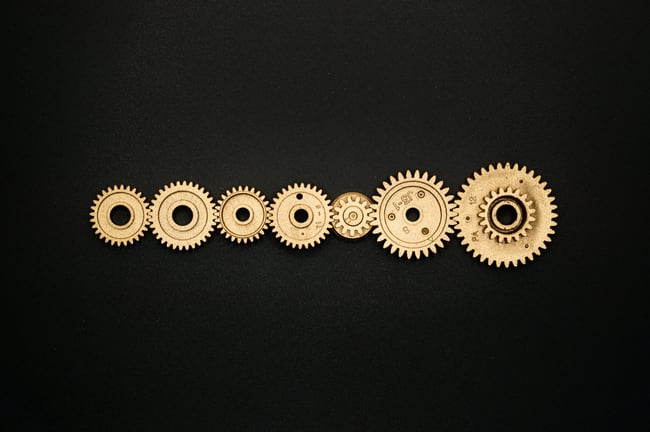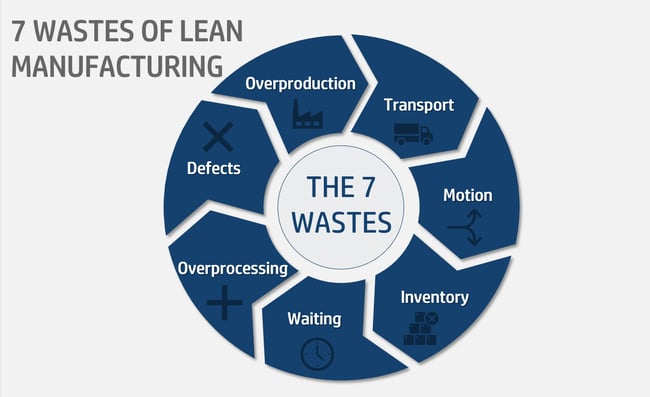 One of the most effective ways to decrease costs and increase profitability within manufacturing operations is to eliminate waste.
One of the most effective ways to decrease costs and increase profitability within manufacturing operations is to eliminate waste.
Lean manufacturing aims to locate waste within production processes and eliminate it through value stream mapping. This is the process of locating areas of production that are not found to be beneficial (i.e. they do not add value) and eliminating them to create a much leaner manufacturing operation.
Lean manufacturing originated in Japan and identifies “Seven Wastes in Manufacturing" where waste is known as “muda”.
To eliminate these wastes and streamline your production, it is important to understand what they are and where they exist. While products can vary greatly from one manufacturing facility to another, these seven wastes are found within most manufacturing environments. Therefore, here are the seven types of wastes identified within Lean Manufacturing.
The Seven Types of Waste Within Lean Manufacturing

The seven types of waste within lean manufacturing are:
- Overproduction - As its name suggests, overproduction occurs when you produce too much of an item. This often occurs when you manufacture an item before it is actually required. Overproduction is extremely costly to a manufacturing facility as it disrupts the flow of materials, and can degrade the quality of the item and the overall productivity of the facility. A Just-In-Time (JIT) production strategy was developed to deal with this type of waste as items are made only when they are needed. An overproduction model is also referred to as “Just in Case” and creates excessive lead times, high storage costs, and makes it difficult to detect defects.
- Transport - The transportation of products does not directly add value to the product and excessive movement and handling can cause damage to the product. This can cause the quality of the product to deteriorate. Excessive transport can occur when the operation steps do not flow well and require the additional transport of materials from one part of the facility to another. Reducing transportation waste involves mapping out the layout of the production facility and changing it so that downstream operations are close and flow well.
- Unnecessary / Excess Motion - This type of waste refers to the excess motion of workers within the facility as they walk, bend, and stretch to get tools and additional materials. While these movements cause additional delays in production, they can represent health and safety issues for the workers. Production facilities should analyze each operation step and aim to minimize the amount of motion required by the workers.
- Unnecessary Inventory - Work in process (WIP) items are a result of overproduction and waiting, and excess inventory only hides problems on the plant floor. Holding items in inventory represents one of the largest costs incurred by manufacturing facilities. In addition, excess inventory can increase lead time, consume productive floor space, and delay problem identification. When you can achieve a seamless workflow between work centers, you will be able to employ JIT production strategies and reduce inventory levels and associated costs.
- Waiting - This type of waste refers to when a product or WIP item is not moving or being processed. In batch-and-queue manufacturing, much of a product’s life cycle is spent waiting. This usually occurs when material flow is poor, production cycle times are too long, and distances between work centers are too great. The Theory of Constraints states that an hour lost in a bottleneck process is an hour lost to the factory’s output and can never be recovered. To help reduce this type of waste, it is helpful to link processes together so that one operation feeds directly into the next with minimal waiting.
- Over-Processing - Over-processing waste refers to doing more work than is necessary and involves redundant activities that do not add value to the product such as re-inspecting, re-counting, or excessive documentation. These steps are usually performed by workers which represent one of the highest costs in a production facility. This can also include using expensive production equipment when cost-effective tools are just as sufficient. Investing in smaller and more flexible equipment pieces where it is possible will enable you to save a substantial amount of money within your operation.
- Defects - Defects within an organization end up costing money. Any rework or scrap represents a substantial cost to organizations. Any of these costs include quarantining inventory, re-inspecting, loss of capacity, and rescheduling. With employee involvement and continuous process improvement (CPI), there is an opportunity for your facility to reduce defects at many facilities. Improving processes will ideally increase the quality of products and lead to less waste due to defects.
Lean manufacturing strategies are extremely beneficial for eliminating waste within your manufacturing operation. Advanced Planning and Scheduling (APS) software can easily aid in the implementation of Lean Manufacturing techniques. This software is a visual production planning and scheduling tool that allows manufacturers to identify areas that do not add value to the production process. In addition, techniques such as Just-In-Time production scheduling are easily implemented with an APS system like PlanetTogether APS. This allows manufacturers to create the most efficient production plan to cut costs and increase profits.
The shift to PlanetTogether is saving us about 15% in inventory overhead and about 20% in overtime labor expenses. We're not building to stock any longer - we're building to ship.
BRUCE HAYS, DIRECTOR OF MANUFACTURING, J&J SYNTHES
Advanced Planning and Scheduling (APS) Software
Advanced Planning and Scheduling Softwares have become a must for modern-day manufacturing operations as customer demand for increased product assortment, fast delivery, and downward cost pressures become prevalent. These systems help planners save time while providing greater agility in updating ever-changing priorities, production schedules, and inventory plans. APS Systems can be quickly integrated with an ERP/MRP software to fill the gaps where these systems lack planning and scheduling flexibility, accuracy, and efficiency.
With PlanetTogether APS you can:
- Create optimized schedules that balance production efficiency and delivery performance
- Maximize throughput on bottleneck resources to increase revenue
- Synchronize supply with demand to reduce inventories
- Provide company-wide visibility to resource capacity
- Enable scenario data-driven decision making
The implementation of an Advanced Planning and Scheduling (APS) Software will take your manufacturing operations to the next level of production efficiency by taking advantage of the operational data you already possess in your ERP system. APS is a step in the right direction of efficiency and lean manufacturing production enhancement. Try out a free trial or demo!
Related Lean Manufacturing Video
APS Resources